Reducing Residual Stresses in Synthetic Cast Iron by Ti Microalloying
Abstract
1. Introduction
- Resistance from the mold against the casting’s natural shrinkage (shrinkage stresses);
- Uneven cooling rates across different sections of the casting (thermal stresses);
- Volume changes during phase transformations (transformation stresses).
2. Materials and Methods
- Increasing the overheating temperature to 1500 °C (compared to the standard 1420 °C) in combination with inoculation techniques.
- Alloying with titanium (also overheating to 1500 °C and inoculation).
- Adjusting the carbon content by increasing it by 0.5% while reducing the silicon content.
- Chemical analysis.
- R-block, with different thicknesses: 100 mm, 50 mm, and 20 mm, to assess the sensitivity of casting hardness to various wall thicknesses and cooling rates—Figure 1. The HB hardness was measured in cut sections in an R-block at each diameter. The measurement was performed using an HPO 3000 (Povazska Bystrica, Slovakia) hardness tester set to a 10 mm diameter test ball, applying a force of 3000 N for 10 s.
- Tensile strength (Rm) testing was performed on test bars with a diameter of 30 mm using a ZwickRoell (Ulm, Germany) testing machine. The bars for the tensile test were cast separately, in accordance with the foundry’s regulations. Three measurements were taken from each melt.
- Sipp test for residual stress measurement, Figure 2. Note that the Sipp test will be discussed later in Section 3.2.2.
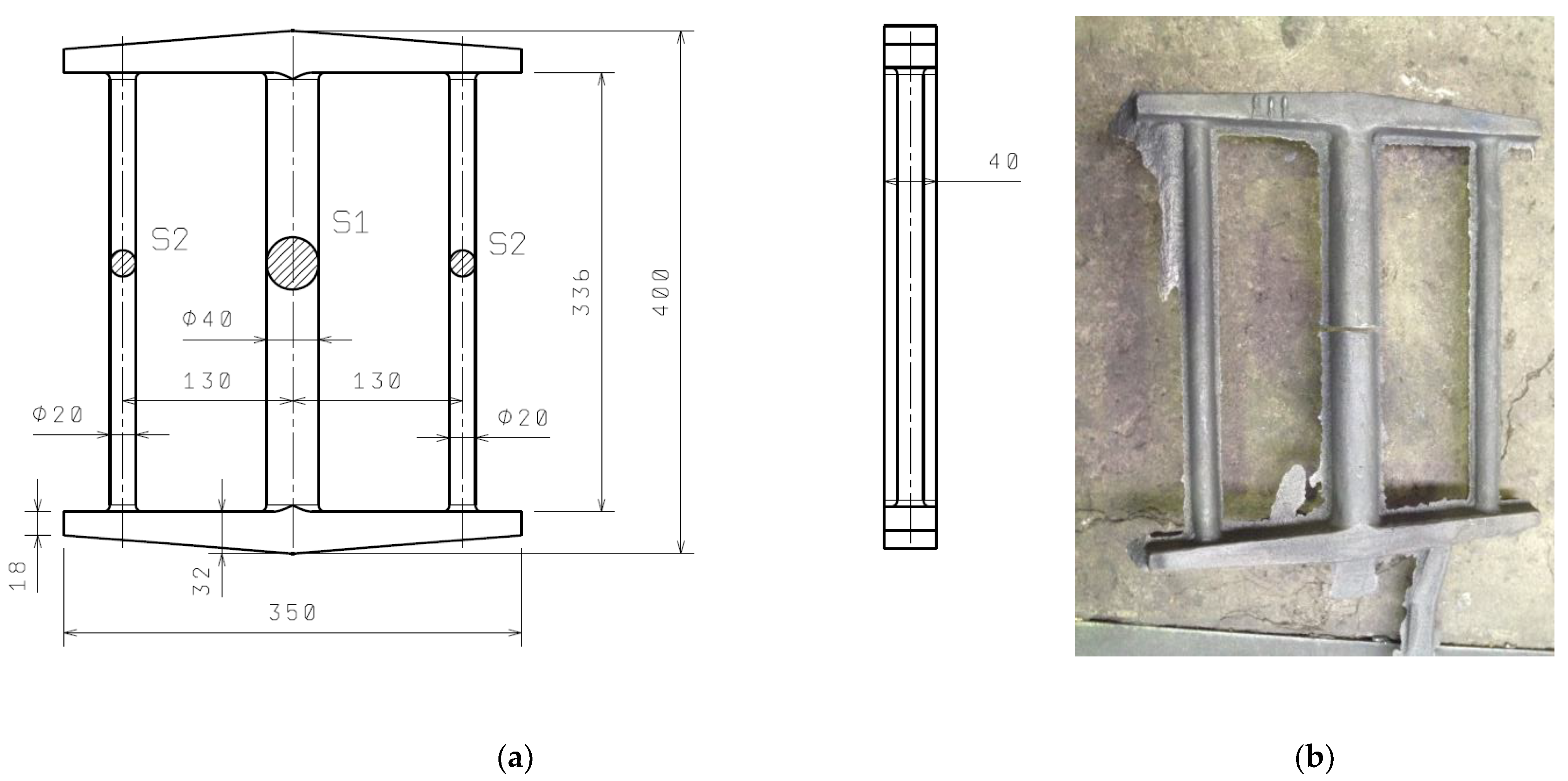
- Metallographic analysis was performed on samples taken from the test bars and prepared according to standard procedures.
3. Results
3.1. Metallographic Analysis
3.2. Analysis of Selected Melts
3.2.1. Hardness HB
- A
- Cast iron produced in a traditional way (Melt No. 1);
- B
- Inoculated cast iron (FeSi75), overheated to 1500 °C, microalloyed FeTi70 (Melt No.3);
- C
- Synthetic cast iron, inoculated with FeSi75, overheated to 1500 °C and microalloyed with FeTi70 (Melt No. 6).
3.2.2. Residual Stresses
- Non-destructive;
- Semi-destructive;
- Destructive methods.
4. Conclusions
- (1)
- By comparing castings with added Ti made from pig iron and steel scrap (synthetic cast iron), lower levels of residual stresses were measured on the synthetic alloy.
- (2)
- In the samples with added Ti (No. 3 and No. 6), there was a significant decrease in the residual stress levels compared to the casting without added Ti (No. 1); see Table 6. Microalloying with FeTi70 positively affects the sensitivity of the dispersion of the mechanical properties of cast iron due to the change in the wall thickness of the casting, as well as the reduction in residual stresses. In synthetic cast iron (melt No. 5), carbides were observed in the structure (Figure 4). By microalloying Ti, their presence in the structure of synthetic cast iron (melt No. 6) was not confirmed, which also has a positive effect on residual stresses.
- (3)
- Based on the measured values in the upper and lower fibers for all three castings, it can be concluded that residual stresses not only from tension/compression but also from bending occurred during the cooling process; see Table 5.
- (4)
- From the analysis of the hardness measured on the R block, it can be concluded that the addition of FeTi70 caused a decrease in the HB hardness of synthetic cast iron and the dispersion of HB hardness in the thick part of the casting compared to the thin part was very small (less than 5%; see Figure 11).
Author Contributions
Funding
Data Availability Statement
Acknowledgments
Conflicts of Interest
References
- Riposan, I.; Chisamera, M.; Stan, S. Enhanced quality in electric melt grey cast irons. ISIJ Int. 2013, 53, 1683–1695. [Google Scholar] [CrossRef]
- Kukartsev, V.A.; Cherepanov, A.I.; Kukartsev, V.V.; Mikhalev, A.S.; Makarchuk, I.Y. Increasing the Efficiency of Production of Synthetic Cast Iron. Key Eng. Mater. 2021, 904, 3–8. [Google Scholar] [CrossRef]
- Futas, P.; Pribulova, A.; Petrik, J.; Pokusova, M.; Junakova, A. The study of synthetic cast iron quality made from steel scrap. In Proceedings of the 18th International Multidisciplinary Scientific GeoConference Surveying Geology and Mining Ecology Management, Albena, Bulgaria, 2–8 July 2018; pp. 321–329. [Google Scholar] [CrossRef]
- Snigir, A.N.; Savitsky, E.M.; Saikin, V.T.; Petrov, G.B. Control over the process of formation of the structure and properties of cast iron by thermal analysis method. Thermochim. Acta 1985, 93, 657–660. [Google Scholar] [CrossRef]
- Dey, A.K. Energy efficiency model for induction furnace. IOP Conf. Ser. Mater. Sci. Eng. 2018, 302, 012047. [Google Scholar] [CrossRef]
- Sarkar, T.; Bose, P.K.; Sutradhar, G. Mechanical and tribological characteristics of copper alloyed austempered gray cast iron (AGI). Mater. Today Proc. 2008, 5, 3664–3673. [Google Scholar] [CrossRef]
- Kaczorowski, M.; Myszka, D. On the differences between mechanical properties and structure of ductile iron castings austempered using conventional and direct method. Int. J. Manuf. Sci. Technol. 2005, 7, 33–39. [Google Scholar]
- Medyński, D.; Janus, A. Effect of Cr, Mo and Al on Structure and Selected Mechanical Properties of Austenitic Cast Iron. Arch. Foundry Eng. 2019, 19, 39–44. [Google Scholar] [CrossRef]
- Hanqi, H.; Qujie, Z. Effect of Nitrogen on Matrix Structure of Gray Cast Iron. Acta Metall. Sin. (Engl. Ed.) Ser. A 1993, 6, 370–372. [Google Scholar]
- Kagawa, A.; Okamoto, T. Partition of Alloying Elements in Freezing Cast Irons and Its Effect on Graphitization and Nitrogen Blowhole Formation; The Institute of Scientific and Industrial Research Osaka University: Ibaraki, Japan, 2011. [Google Scholar]
- Callister, W.D. Materials Science and Engineering; Department of Metallurgical Engineering, The University of Utah: Salt Lake City, UT, USA, 2009; ISBN 978-0-471-73696-7. [Google Scholar]
- Collini, L.; Nicoletto, G.; Konecna, R. Microstructure and mechanical properties of pearlitic gray cast iron. Mater. Sci. Eng. 2008, 488, 529–539. [Google Scholar] [CrossRef]
- Wilberfors, F.; Svensson, I. The effect of nitrogen and inoculation on the tensile properties and microstructure of cast iron lamellar. Key Eng. Mater. 2010, 457, 114–119. [Google Scholar] [CrossRef]
- Futas, P.; Jelč, I.; Vasková, I.; Fedorko, G.; Molnár, V.; Kačmáry, P. The Gist of thermal stresses of cast iron castings. Manuf. Technol. 2013, 13, 173–178. [Google Scholar]
- Balasingh, C.; Seshadri, M.R.; Srinivasan, M.N.; Ramaseshan, S. Effect of carbon equivalent and inoculation on residual stresses in grey iron castings. J. Mech. Work. Technol. 1984, 9, 53–66. [Google Scholar] [CrossRef]
- Johnson, E.M.; Watkins, T.R.; Schmidlin, J.E.; Dutler, S.A. A Benchmark Study on Casting Residual Stress. Metall. Mater. Trans. A 2012, 43, 1487–1496. [Google Scholar] [CrossRef]
- Keste, A.A.; Gawande, S.H.; Sarkar, C. Design optimization of precision casting for residual stress reduction. J. Comput. Des. Eng. 2016, 3, 140–150. [Google Scholar] [CrossRef]
- Marberg, A.; Pal, J. Residual Stresses in Cast Iron, Diploma Work No. 200/b, Chalmers University of Technology, Gothenburg, Sweden. Available online: https://odr.chalmers.se/server/api/core/bitstreams/23f255d3-d43c-4996-8c45-4691960a15f3/content (accessed on 30 March 2025).
- Tian, G.; Bu, K.; Tian, Q.; He, J. A Casting Shrinkage Prediction Method Based on Model Automated Self-correction Strategy. Int. J. Met. 2024, 18, 1052–1061. [Google Scholar] [CrossRef]
- Motoyama, Y.; Shiga, H.; Sato, T.; Sato, T.; Kambe, H.; Yoshida, M. Effects of Recovery Behavior and Strain-Rate Dependence of Stress–Strain Curve on Prediction Accuracy of Thermal Stress Analysis During Casting. Metall. Mater. Trans. A 2017, 48, 2960–2970. [Google Scholar] [CrossRef]
- Futas, P.; Pribulova, A.; Petrik, J.; Blasko, P.; Junakova, A.; Sabik, V. Metallurgical Quality of Cast Iron Made from Steel Scrap and Possibilities of Its Improvement. Metals 2023, 13, 27. [Google Scholar] [CrossRef]
- Gedeonová, Z.; Vondrák, V. Kontrola Kvality Odliatkov; Alfa: Bratislava, Slovakia, 1983; ISBN 6373883. [Google Scholar]
- Available online: https://www.hbm.com/ (accessed on 30 March 2025).
- Yang, Y.; Zhang, L.; Yuan, Y.; Sun, J.; Che, Z.; Qiu, Z.; Du, T.; Na, H.; Che, S. Muti-objective optimization on energy consumption, CO2 emission and production cost for iron and steel industry. J. Environ. Manag. 2023, 3471, 119102. [Google Scholar] [CrossRef] [PubMed]
- Turakulov, M.; Tursunov, N.; Yunusov, S. New concept of cast iron melting technology in induction crucible furnace. E3S Web Conf. 2023, 401, 01060. [Google Scholar] [CrossRef]
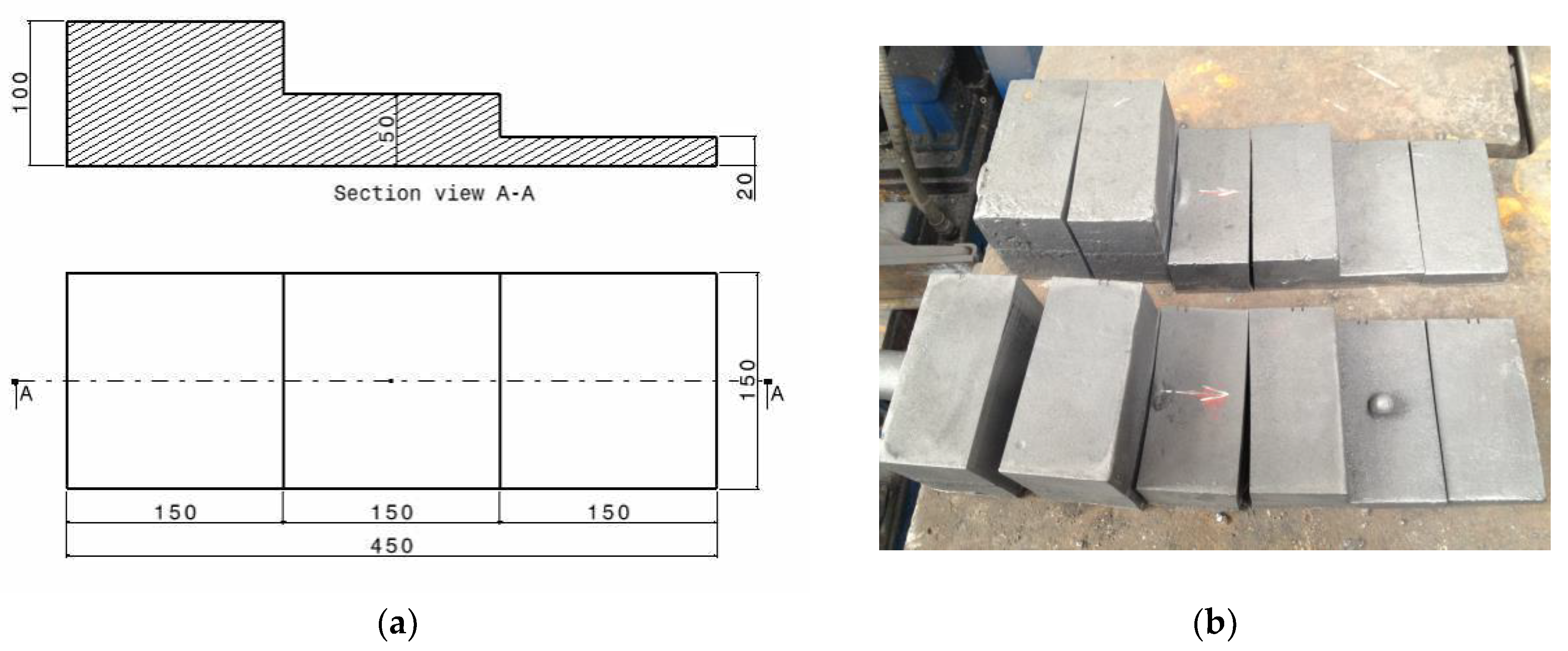
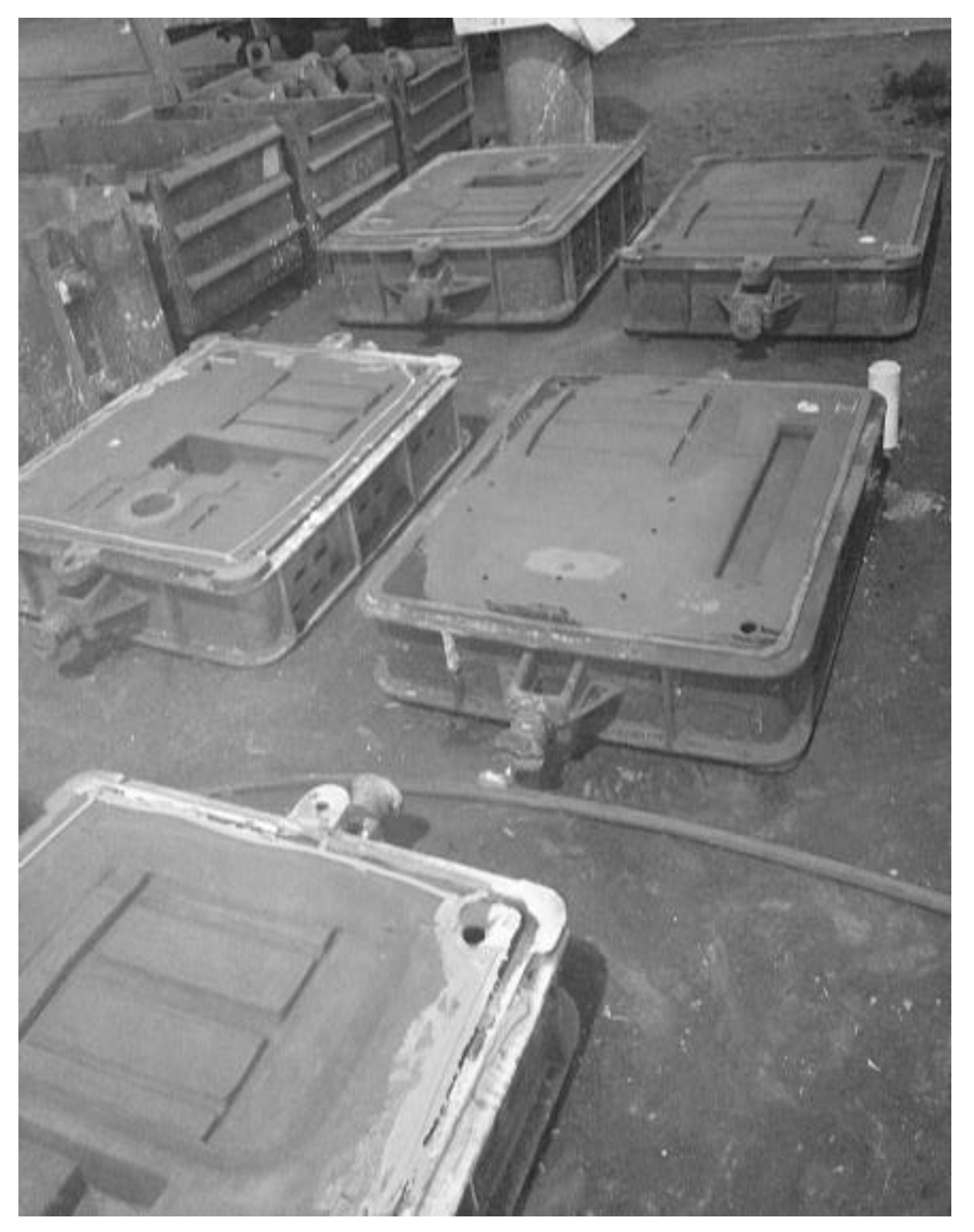

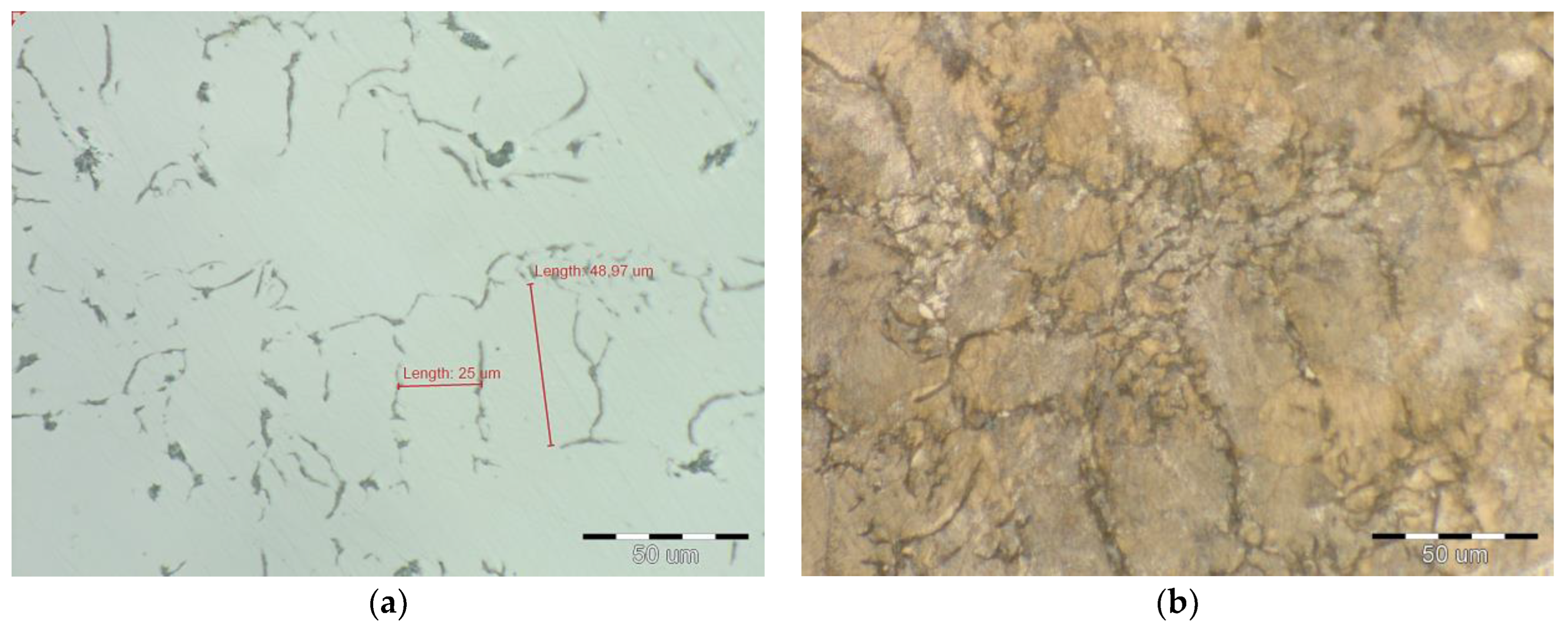
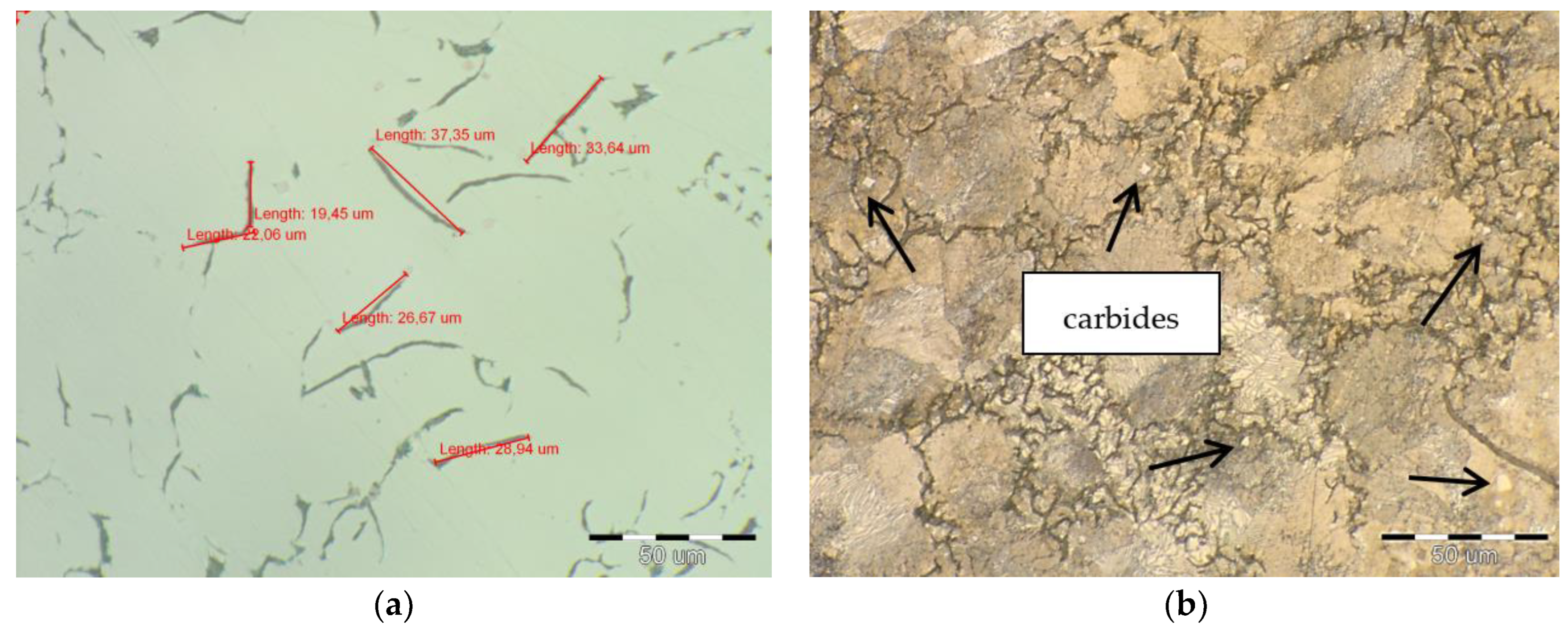
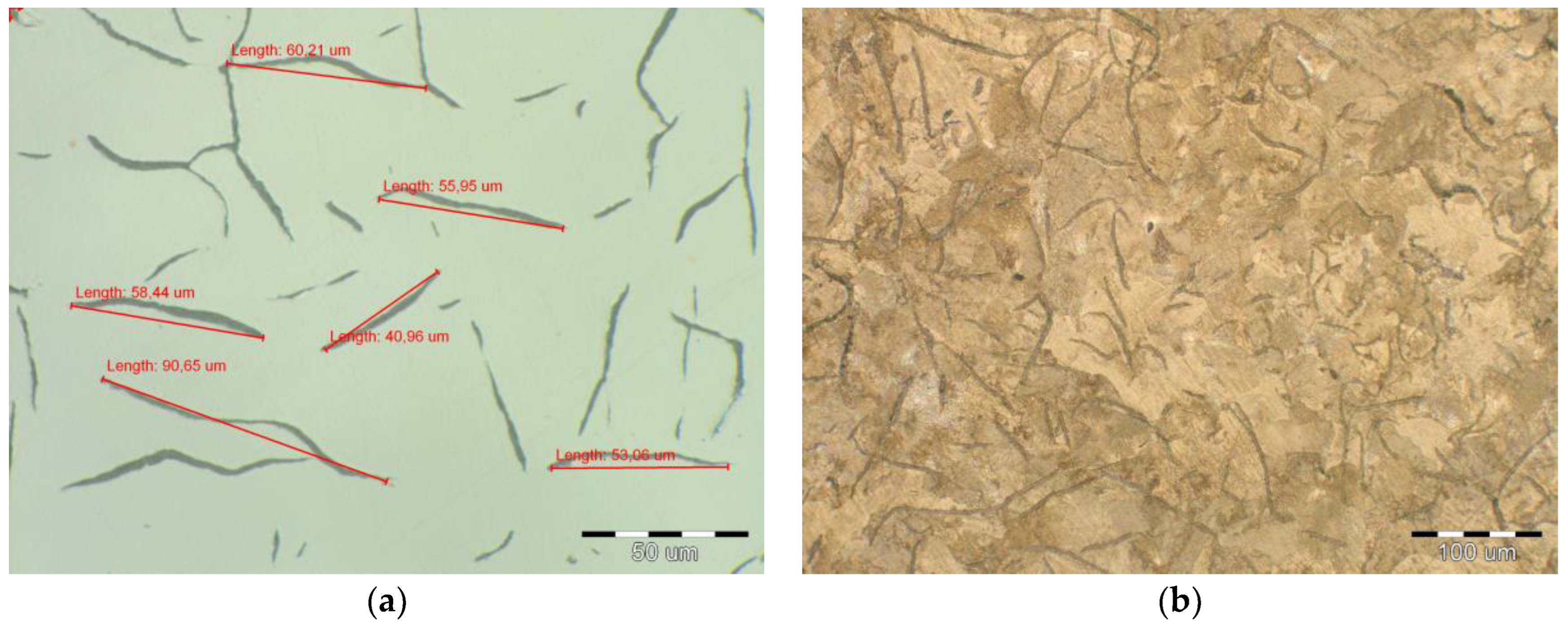
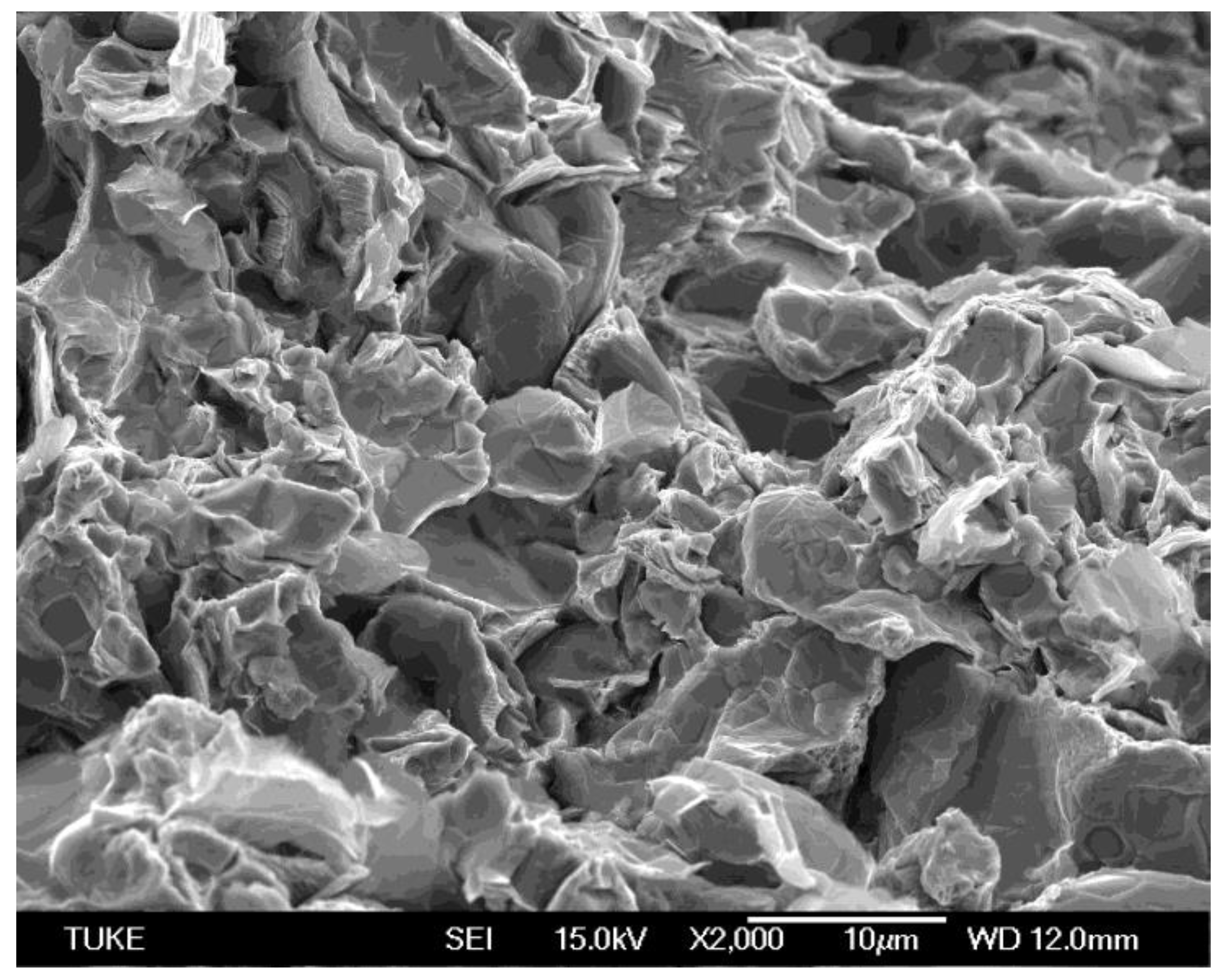
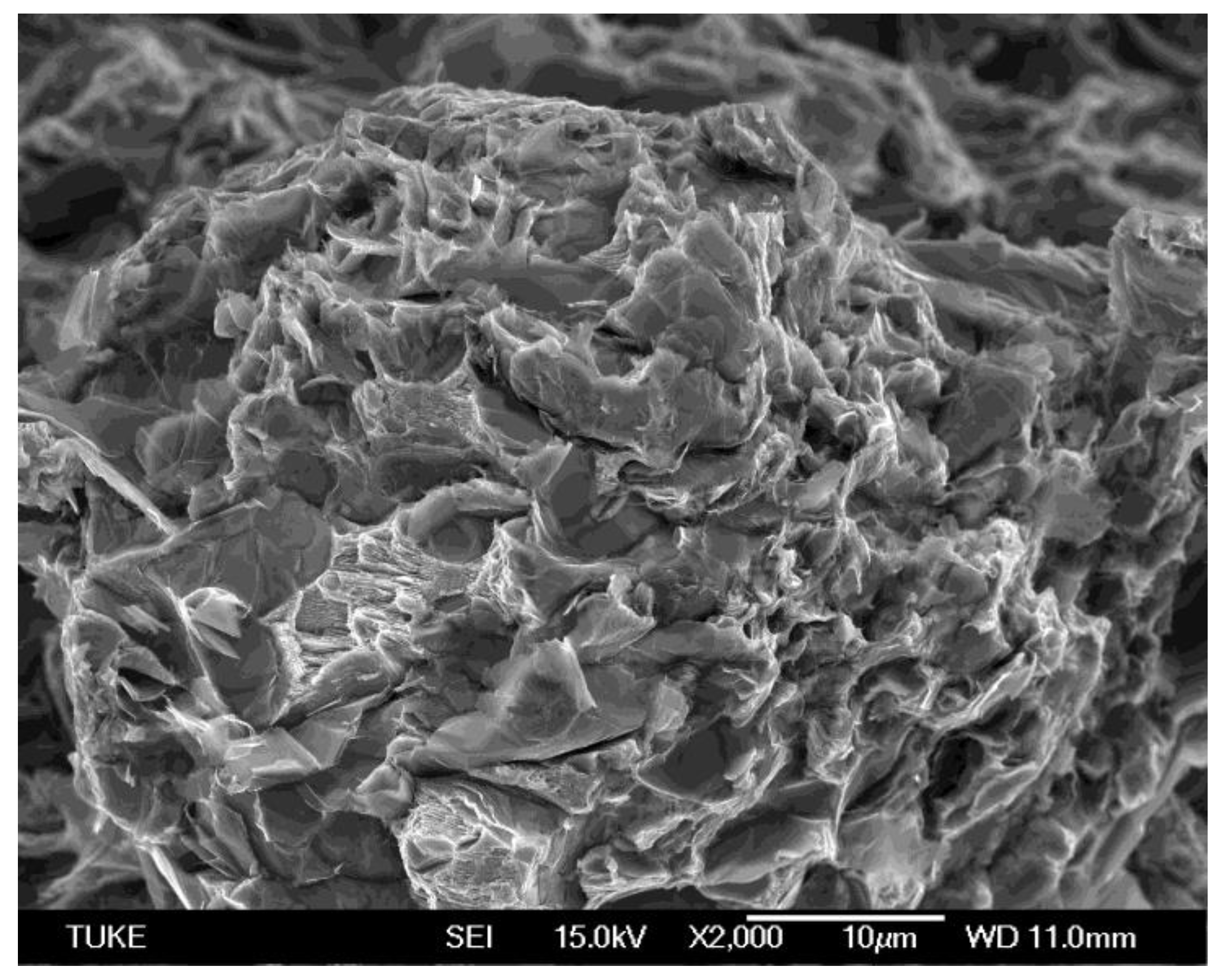
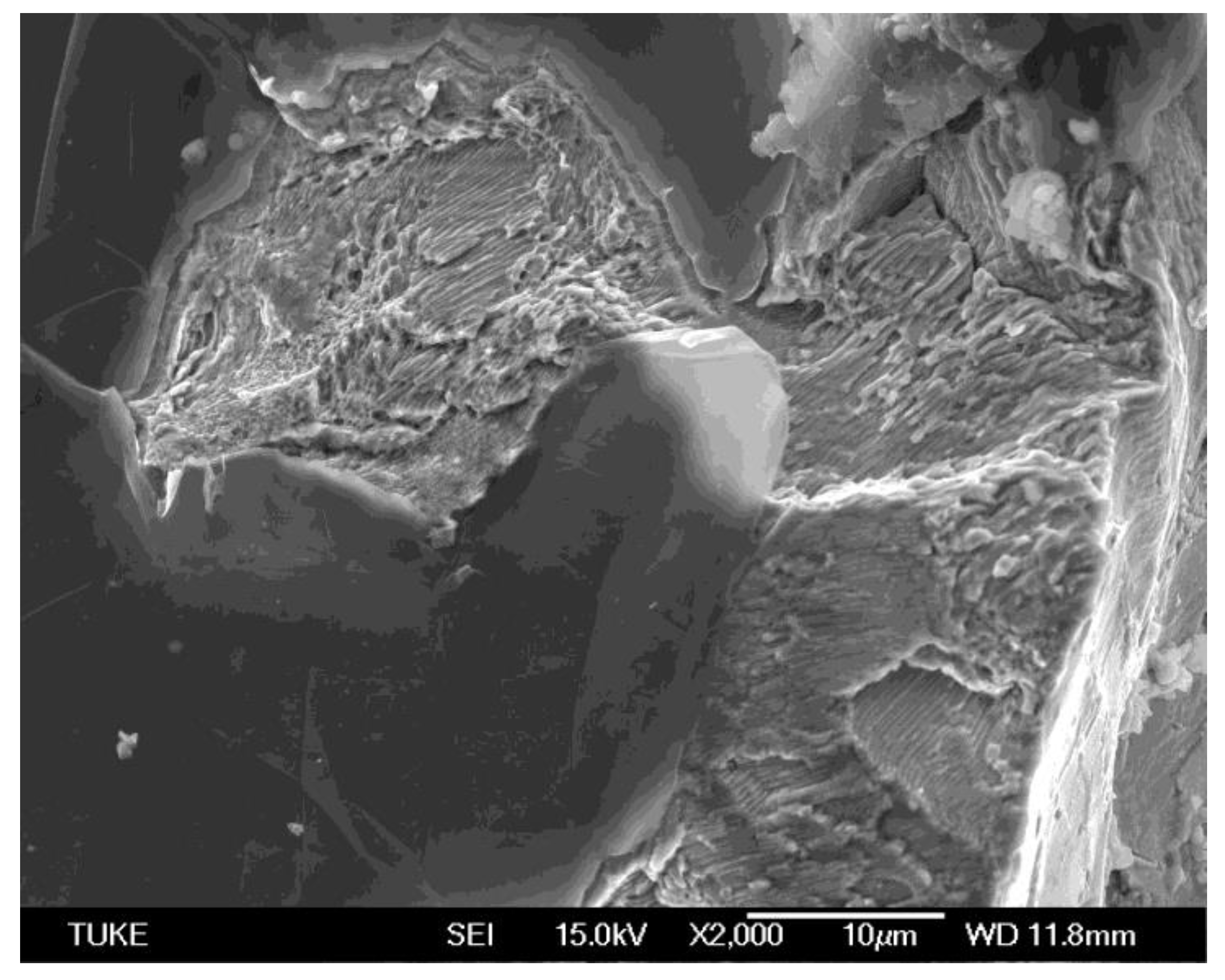
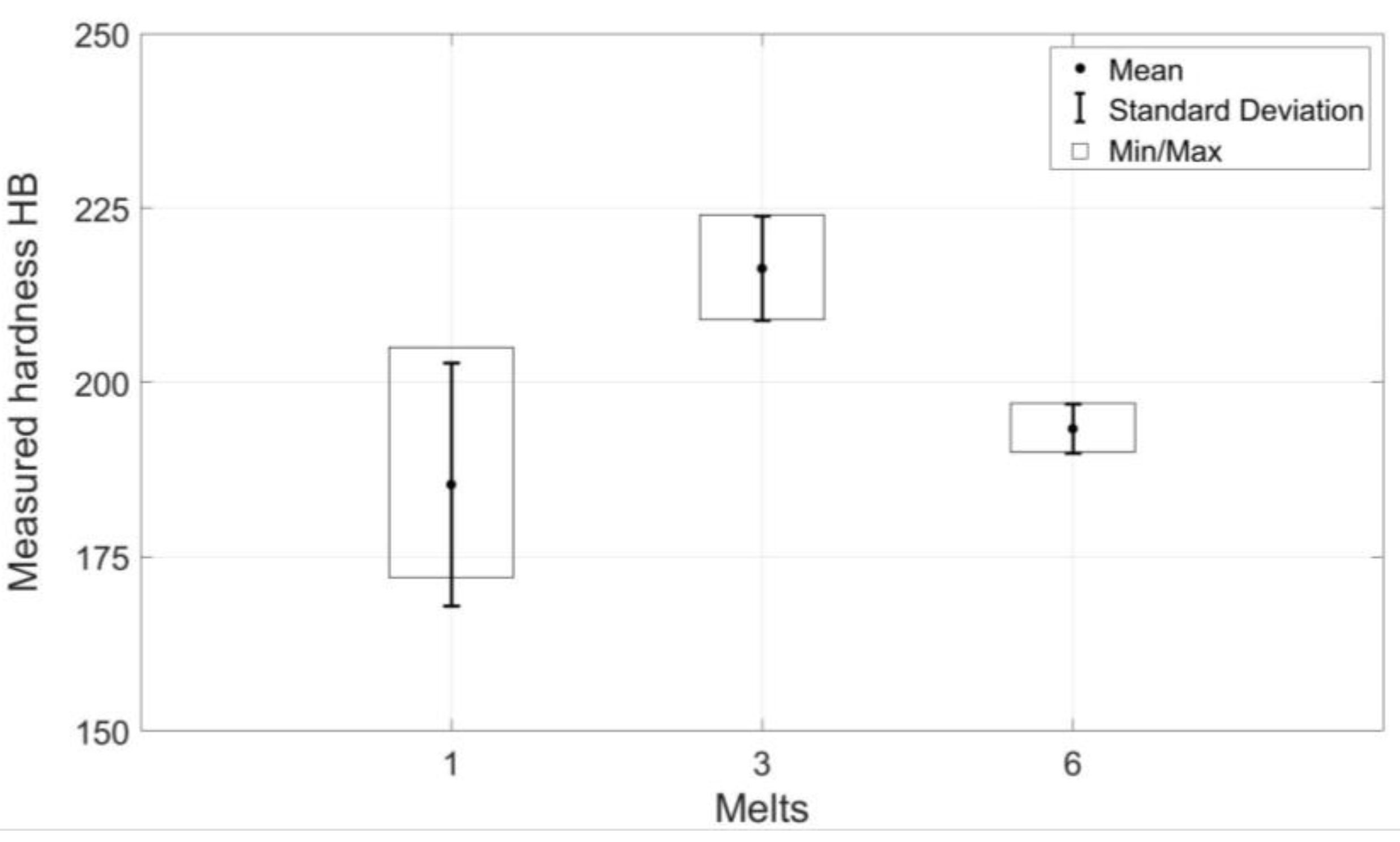



| Melt No. | Charge Material (wt. %) | Temperature [°C] | |||||||
|---|---|---|---|---|---|---|---|---|---|
| Steel Scrap (Sheet Metal) | Return Material | PIG iron | FeSi75 | FeMn80 | Carburizer (Desulco 9001) | Inoculant (Added to the Iron Stream) | FeTi70 | ||
| 1 | 32.8 | 53.3 | 10 | - | 0.4 | 1.3 | 0.20 | - | 1420 |
| 2 | 35.5 | 52.9 | 9.8 | 0.12 | 0.5 | 0.98 | 0.20 | - | 1500 |
| 3 | 35.5 | 52.9 | 9.8 | 0.12 | 0.5 | 0.98 | 0.20 | 0.28 * | 1500 |
| 4 | 82.7 | - | 13 | 0.22 | 0.47 | 3.45 | 0.20 | - | 1450 |
| 5 | 97.8 | - | - | 0.59 | 0.4 | 0.67 | 0.34 + 0.2 ** | - | 1450 |
| 6 | 97.5 | - | - | 0.60 | 0.47 | 0.67 | 0.50 | 0.26 * | 1520 |
| Melt No. | Charge Material (wt. %) | Sc | CE [%] | Tensile Strength [MPa] | Hardness HB | ||||||
|---|---|---|---|---|---|---|---|---|---|---|---|
| C | Si | Mn | P | S | Ti | N | |||||
| 1 | 3.23 | 1.612 | 0.657 | 0.024 | 0.025 | - | 0.0113 | 0.848 | 3.721 | 297 | 186///205 * |
| 2 | 3.33 | 1.52 | 0.664 | 0.024 | 0.021 | - | 0.0113 | 0.868 | 3.793 | 352 | 204///223 * |
| 3 | 3.32 | 1.486 | 0.658 | 0.023 | 0.021 | 0.183 | 0.0091 | 0.863 | 3.773 | 268 | 217///224 * |
| 4 | 3.79 | 1.026 | 0.773 | 0.018 | 0.012 | - | 0.0073 | 0.951 | 4.103 | 256 | 211///221 * |
| 5 | 3.28 | 1.69 | 0.84 | 0.06 | 0.016 | - | 0.0175 | 0.869 | 3.805 | 258 | 243///312 * |
| 6 | 3.13 | 1.61 | 0.79 | 0.016 | 0.011 | 0.192 | 0.0205 | 0.821 | 3.618 | 220 | 197///209 * |
| Melt No. | Perlite Content | Graphite Size [µm] | Perlite Content |
|---|---|---|---|
| 1 | 92 | 60–120 | Type C—mixed |
| 3 | 96 | 30–60 | Type E—interdendritic undirected |
| 5 | 100 | 60–250 | Type C—mixed |
| 6 | 96 | 60–120 | Type C—mixed |
| Melt No. | Charge Material (wt. %) | Temperature [°C] | |||||||
|---|---|---|---|---|---|---|---|---|---|
| Steel Scrap (Sheet Metal) | Return Material | PIG iron | FeSi75 | FeMn80 | Carburizer (Desulco 9001) | Inoculant (Added to the Iron Stream) | FeTi70 | ||
| 1 (A) | 32.8 | 53.3 | 10 | - | 0.4 | 1.3 | 0.20 | - | 1420 |
| 3 (B) | 35.5 | 52.9 | 9.8 | 0.12 | 0.5 | 0.98 | 0.20 | 0.28 * | 1500 |
| 6 (C) | 97.5 | - | - | 0.60 | 0.47 | 0.67 | 0.50 | 0.26 * | 1520 |
| Cast No. | Locations | Measured Strains [με] | ||
|---|---|---|---|---|
| 2L (Thin) | 1M (Thick) | 2R (Thin) | ||
| A | top/bottom | 261/335 | −127/−176 | 213/304 |
| B | top/bottom | 145/220 | −79/−112 | 139/271 |
| C | top/bottom | 155/230 | −82/−105 | 177/143 |
| Cast No. | Measured Strains [με] | ||
|---|---|---|---|
| 2L (Thin) | 1M (Thick) | 2R (Thin) | |
| A | 298.0 | −151.5 | 258.5 |
| B | 182.5 | −95.5 | 205.0 |
| C | 192.5 | −93.5 | 160.0 |
Disclaimer/Publisher’s Note: The statements, opinions and data contained in all publications are solely those of the individual author(s) and contributor(s) and not of MDPI and/or the editor(s). MDPI and/or the editor(s) disclaim responsibility for any injury to people or property resulting from any ideas, methods, instructions or products referred to in the content. |
© 2025 by the authors. Licensee MDPI, Basel, Switzerland. This article is an open access article distributed under the terms and conditions of the Creative Commons Attribution (CC BY) license (https://creativecommons.org/licenses/by/4.0/).
Share and Cite
Futas, P.; Brezinová, J.; Pástor, M.; Pribulova, A. Reducing Residual Stresses in Synthetic Cast Iron by Ti Microalloying. Metals 2025, 15, 520. https://doi.org/10.3390/met15050520
Futas P, Brezinová J, Pástor M, Pribulova A. Reducing Residual Stresses in Synthetic Cast Iron by Ti Microalloying. Metals. 2025; 15(5):520. https://doi.org/10.3390/met15050520
Chicago/Turabian StyleFutas, Peter, Janette Brezinová, Miroslav Pástor, and Alena Pribulova. 2025. "Reducing Residual Stresses in Synthetic Cast Iron by Ti Microalloying" Metals 15, no. 5: 520. https://doi.org/10.3390/met15050520
APA StyleFutas, P., Brezinová, J., Pástor, M., & Pribulova, A. (2025). Reducing Residual Stresses in Synthetic Cast Iron by Ti Microalloying. Metals, 15(5), 520. https://doi.org/10.3390/met15050520







